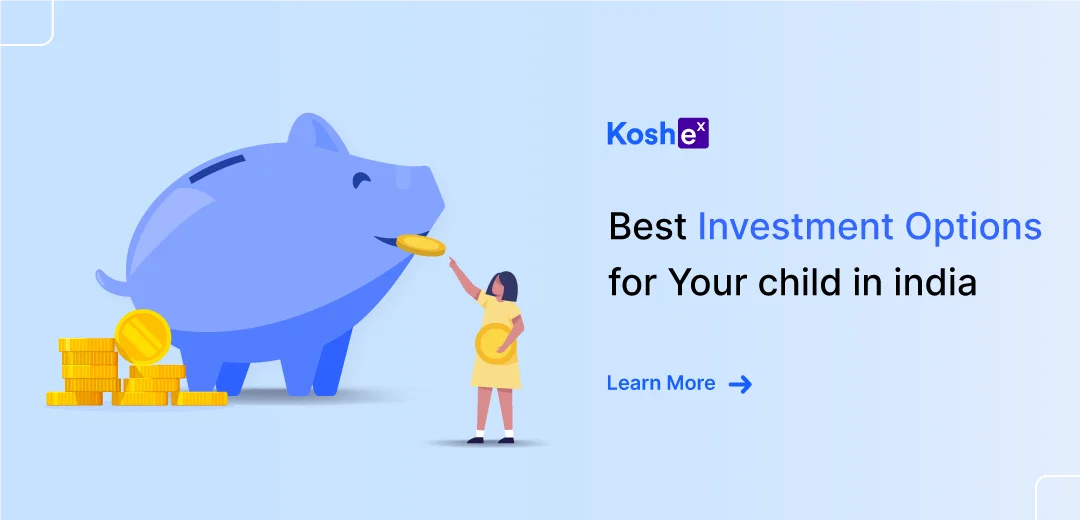Best investment plan for the child
We all want to provide our children with the best higher education and a financially secure future. However, it’s a great idea to start saving and investing early so that you have sufficient funds for when you need them.
You must choose the investment options that match your risk profile and help you create a corpus to secure your child’s future.
You can sign up with Koshex for more customized investment solutions.
Start Saving with the Top Child Plans in India 2022
Here are the best investment plans for child
Sukanya Samriddhi Scheme
The Government of India encourages its citizens to save adequately to secure the girl child’s future. You can open a Sukanya Samriddhi Scheme account at any post office.
Some of its requirements are:
- Minimum Deposit Amount: Rs. 250 every financial year
- Maximum Deposit Amount: Rs. 1.5 lakhs every financial year
- Account Opening Details:
- Sukanya Samriddhi’s account should be opened in the name of your daughter.
- You can open it after your daughter’s birth and before she turns 10.
- Only one account can be opened in your daughter’s name; you cannot open two separate accounts.
- The legal or natural guardian of a girl child may also open such an account.
- Besides the post office, you may open Sukanya Samriddhi accounts at 28 authorized banks. These include the State Bank of India (SBI), ICICI Bank, Axis Bank, Punjab National Bank (PNB), UCO Bank, Central Bank of India, Bank of India (BOI), Bank of Baroda (BoB), IDBI Bank, Union Bank of India, among others.
Is this one of the best investment options available? Let’s find out.
The annual interest rate on the account changes every quarter. The yearly compounded rate is 7.6% for October-December 2022.
While this has been the prevailing rate since April 2020, it was significantly higher earlier, as much as 8.4% per annum between April 2017 and March 2020.
You can invest in the Sukanya Samriddhi Scheme till your daughter turns 14. However, the account will mature only after 21 years from the date of account opening. You may partially withdraw money once your daughter is 18. If she marries after turning 18, you can also close the account prematurely.
This investment option gives you dual tax benefits:
- Under Section 80-C of the Income-tax Act, you’ll get a tax deduction.
- Under Section 10 of the Income-tax Act, interest earned under this scheme remains tax-free.
The best thing about this investment for your child is that it provides you with a decent long-term return at low risk. If you want to check the amount your child will receive at maturity, you can use the Sukanya Samriddhi Yojana calculator.
Public Provident Fund (PPF)
If you are looking for a low-risk, low-return, long-term investment option for your child, the PPF is a good investment option. In a financial year, you can invest between Rs. 500 and Rs. 1.5 lakhs.
Although the maturity period is long, i.e., 15 years from the date of opening, your money will be safe. You can even continue investing in your PPF account for one or more five-year blocks after the date of maturity.
Once the account matures, you can retain the account for as long as you want:
- Without having to make any further deposits, and
- Continuing to earn the prevailing interest rate.
The yearly compounded rate is 7.1% for October-December 2022. The annual interest rate on the account changes every quarter. Since 2017, the rate has hovered between 7.1% and 8%.
An important advantage of having a PPF account is that you can avail of a loan facility from the third to the sixth financial year from the date of account opening. From the seventh financial year, withdrawal is allowed.
A PPF account also enables you to have tax deductions under Section 80 C of the Income-tax Act and earn tax-free PPF interest rates.
You can have only one PPF account, either at the post office or a bank. This long-term savings scheme is the perfect investment vehicle for your child’s future as it combines safety, decent returns, and tax savings.
Start saving early so that you can create a larger corpus for your child in the long run. This PPF calculator will help you get an idea about the amount of money you’ll receive during maturity.
Child Insurance Plan
This is a good insurance-cum-investment plan that:
- Grows your investment corpus.
- Takes care of your kid’s higher education needs.
- Secures your kid’s financial future.
- Provides robust life insurance.
Child plans are of two types:
- Unit Linked Child Insurance Plan (ULIP): These investment options are market-linked products. A part of your investment in a ULIP-based child plan is used as a life insurance premium, and the other part is invested in a mix of funds to grow your fund in the long run.
- As these plans allow you to invest in equities, they are subjected to market volatility. Generally, they provide an annual return of 10% – 12% and therefore help your corpus grow faster than rising inflation (which is hovering above 6% currently).
- Child Savings Plan: These plans are not market-linked and are most suitable for risk-averse investors. You get life cover, maturity benefits, and tax savings benefits.
You can choose child insurance investment options if you want to:
- Build a large corpus for your child’s higher education (at premier institutions in India and abroad).
- Get investment returns to beat inflation (which was 7.59% in September 2022).
- Keep provision to withdraw partially for taking care of emergencies.
Another major benefit of this plan is that it provides regular payouts at different ages for your child. This can prove advantageous when you need funds from time to time to take care of your child’s education, marriage, and other important commitments.
To ensure that the child plan remains active even in the case of the insurer’s untimely demise, the insurer can opt for the Waiver Of Premium (WOP) option.
However, this will increase the premium amount. WOP ensures that the child will receive twice as much money than the plan’s sum insured amount.
Final Words
To secure your children’s financial future and meet the various expenses involved, you may try many investment options. Ultimately, what you choose for your child will depend on your specific future requirements.
This will help you create a portfolio that provides a balance between the high growth rate of your corpus and the risk factor.
As a young parent, you could invest in market-linked child insurance plans and equity funds for faster growth of corpus.
If you’re a cautious investor, you could pick low-risk investment options such as fixed deposits, PPF, the National Savings Certificate, or debt funds.
Investing in multiple investment options will create a balanced portfolio that takes care of your child’s future needs effectively. Sign up With Koshex for more information on the best investment options for your child in India.
Frequently Asked Questions (FAQs)
FAQ #1: Is it Prudent to Invest in a Long Term Equity Mutual Fund to meet your Child’s Future Needs in India?
Yes, investing in a mutual fund for 10-15 years to meet your child’s future needs is a prudent decision. Equity mutual funds usually provide a better return than fixed-income investments such as PPF, NSC, or the Sukanya Samriddhi Scheme (SSS).
These mutual funds have historically provided a 12-15% annual return. They will help you create a larger corpus to meet your child’s future needs. You should invest in it if you are comfortable taking higher risks than fixed-income investments.
FAQ #2: Can you Invest in a National Savings Certificate (NSC) to Secure your Child’s Future?
Yes, you can use the National Savings Certificate (NSC) as a risk-free investment option to secure your child’s future. This is a fixed-income investment scheme that is backed by the government of India.
You can invest a minimum amount of ₹1,000 or any amount of your choice in multiples of 100 for 5 years; there is no upper limit. The current interest rate you can earn on your investment in NSC is 6.8% p.a., which compounds annually.
Under the Income Tax Act’s Section 80C, you can also get up to ₹1.5 lakh p.a. exemption from your taxable income in a financial year.









Leave a Comment